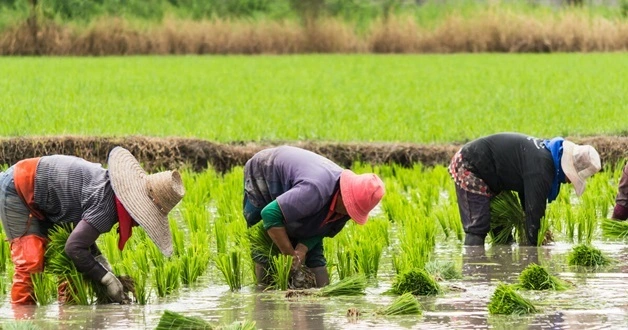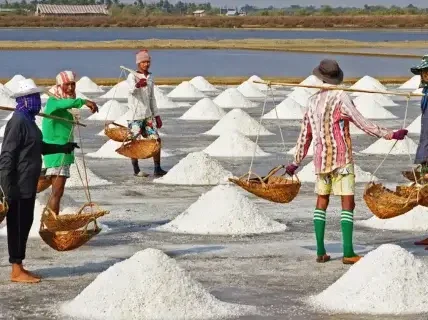It is a fact that Rice happens to be one food that is staple in most of the household around the world. In providing proper sustenance and offering a distinctive cultural identity. Because of the huge demand of rice, paddy cultivation is a popular agricultural practice in most of the countries. The surprising fact is that the most of the rice cultivation is concentrated in Asia, which accounts for a whopping 90% of global production. Here we will be discussing about the top 10 largest rice producers in the world.
1. China: The Pinnacle of Rice Production (149,000,000 MT):
China is the world’s largest rice producer, producing 149 million metric Tons. China diversifies its rice production over its huge agricultural area and several climate zones to meet the needs of its massive population. Modern agriculture and technology boost the nation’s global supremacy. China produces 147.691 million Tons of rice on 29.87 million hectares. The government wants to produce 149 million Tons of rice in 2023–24 to preserve its agricultural supremacy. Rice, originally from the Yangtze River and Yunnan-Guizhou highlands in southern China, is widely grown in China.
2. India: A Giant in Rice Cultivation (132,000,000 MT):
Rice output in India is second to China at 132 million metric Tons. India’s vast agricultural landscape and gastronomic culture depend on rice. Many agro-climatic zones and enormous agricultural regions in India contribute to its extraordinary rice yield. Due to its rich soils, good weather, and traditional production methods, India exports plenty of rice. Agriculture is the nation’s strength, producing 125.039 million Tons on 45.513 million. India’s agricultural dominance will increase with 134 million Tons of rice in 2023–24. Indian kharif rice requires 25°C and 100cm of rain annually. Ploughing, cow dung fertilisation, smoothing, hand-transplanting seeds, and watering are the stages.
3. Bangladesh: Nurturing Growth (36,400,000 MT):
Despite its smaller size than China and India, Bangladesh ranks third in rice production with 36.4 million metric Tons per year. The nation’s dedication to agricultural innovation and efficiency has helped it stand out in global rice production. Bangladesh produces 35.512 million Tons annually on 11.66 million. Bangladesh is predicted to become a significant agricultural player with 37 million Tons of rice in 2023–2024. A staggering 75% of Bangladesh’s agricultural area is used for rice cultivation, which accounts for 28% of its GDP. Bangladeshi rice agriculture adapts to seasonal water availability. November and December saw the largest ‘Aman’ harvest, generating over half of the annual production. Part of the rice for the ‘Aman’ crop is disseminated and matures during the summer rains before being harvested in the autumn.
4. Indonesia: Sustaining the Archipelago (34,450,000 MT):
Fourth-largest rice producer Indonesia produces 34.45 million metric Tons annually. Indonesia’s diverse climate and vast paddy fields make rice production ideal. Proactive agricultural policies and excellent farmer support networks have increased rice yield, showing the nation’s commitment to agriculture. On 11.53 million hectares, Indonesia generates 34.36 million Tons of agricultural output. The 34.45 million Tons of rice Indonesia produced in 2023–24 reinforces its global agricultural supremacy. Indonesia’s major cuisine is rice, which provides almost half the daily calories. Late 1980s rice supported 20 million households, or 100 million people. Indonesia’s rice production has grown thanks to government irrigation. Between 1969 and 1989, 1.2 million hectares were irrigated and 2.5 million restored. The irrigation techniques have enhanced rice output, agricultural sustainability, and Indonesia’s global rice production.
5. Vietnam: Rice Bowl of Southeast Asia (27,000,000 MT):
Vietnam, the ‘Rice Bowl of Southeast Asia,’ produces 27 million metric Tons of rice, seventh worldwide. Vietnam grows rice on the complex Mekong Delta river network. Rice output has increased due to modern cultivation. Vietnamese agriculture produces 27.10 million Tons, grown on 7.30 million hectares. The country will produce 27 million Tons of rice in 2023–2024. Food and revenue come from Mekong and Red River delta rice farming in Vietnam. Vietnam eats seventh-most rice and exports second-most after Thailand. Mekong Delta markets, residences, boats, and water generate 70% of Vietnam’s rice. The northern delta (tropical monsoon region with chilly winters), southern delta (dominated by the Mekong Delta), and northern highlands (including upland rice kinds) influence rice production in Vietnam’s 33 million hectares.
6. Thailand: Orchestrating a Rice Symphony (19,500,000 MT):
Thailand, famed for its fragrant rice varieties, produces 19.5 million metric Tons of rice, sixth globally. Thailand dominates rice production due to its agricultural research and climate. Thai rice exports have increased due to worldwide favourites including Jasmine and Basmati. Agriculture is seen in Thailand’s 19.39 million Tons of rice, farmed on 10.55 million hectares. The country is expected to produce 19.70 million Tons of rice in 2023–2024, increasing its agricultural status. Thai economy and labour depend on rice farming. Rice cultivation drives Thailand’s economy, with 40 million farmers and 16 million rice harvesters. Despite floods and drought reducing second-crop productivity, the Ministry of Agriculture estimated 27–28 million metric Tons (30–31 million short Tons) of combined main and second-crop paddy production in 2019–2020
7. Philippines: A Tropical Rice Haven (12,600,000 MT):
The tropical Philippines produces 12.6 million metric Tons of rice, sixth worldwide. The Philippines uses sustainable agricultural methods and laws to meet rice demand despite typhoons and unpredictable weather. Philippine agriculture yields 12.243 million Tons (5-year average; 2018/19–2022/23) on 4.75 million hectares. The Philippines’ economy and food supply depend on rice cultivation. The nation proudly produces 2.8% of the world’s rice, ranking tenth. The Philippines increased irrigation infrastructure to enhance agricultural productivity. With less than 500,000 hectares in the mid-1960s, irrigated land reached 1.5 million in 2009. This development uses water to irrigate 50% of the irrigation potential.
8. Burma (Myanmar): Harnessing Agricultural Potential (12,000,000 MT):
Myanmar (formerly Burma) produces 12 million metric Tons of rice yearly, tenth worldwide. This country’s abundant territory and agricultural potential boost worldwide rice production. Myanmar’s vigorous agricultural modernization has increased productivity and the economy. Myanmar cultivated 12.53 million Tons of rice on 6.93 million hectares, proving its agricultural strength. With good performance, 2023–24 rice production might reach 12.50 million Tons. Myanmar generates about 43% of its agricultural production from rice, the seventh-largest producer worldwide. Agriculture occupies 12.8 million of Myanmar’s 67.6 million hectares. Myanmar has depended on rice, a versatile crop.
9. Pakistan: Navigating Agricultural Challenges (9,000,000 MT):
Pakistan is the ninth-largest rice producer, producing 9 million metric Tons yearly despite water shortages and diverse climates. Agricultural research and cutting-edge technologies have helped the nation overcome these issues and sustain rice yield, improving food security. Pakistan’s rice industry is robust, producing 7.53 million Tons (5-year Average; 2018/19 – 2022/23), cultivated on 3.14 million hectares. It is expected to generate 9 million Tons of rice in 2023–2024 with improvement. Pakistan is a major rice grower. Rice is crucial to Pakistan’s economy and beyond. The sector supports a large population and increases agricultural exports. Pakistan dominates the global rice trade with around 8%. Rice generates exports and employs a major portion of the workforce.
10. Brazil: Tradition Meets Innovation (7,370,000 MT):
Brazil is significant to the global rice sector owing to its huge agricultural land and excellent weather. Brazil produces a lot of rice while focusing on other crops. Brazil produces 7.37 million Tons of rice on 1.63 million hectares. Production should stay robust with 6.8 million Tons in 2023–2024. The USDA expects Santa Catarina and Rio Grande do Sul to harvest most of Brazil’s rice crop, 7.2 million Tons or 22,700 thousand hectares in 2022. These 12,500 km2 subtropical states boost Brazil’s rice production. Brazil’s rice industry thrives owing to its agricultural resources and climate. Brazil produces several crops, but its rice output is remarkable. As Brazil improves in sustainable and technological farming, its role in the global rice market will be crucial for food security and commerce.
Conclusion:
The aforementioned countries have shown marked success in producing high quantity of rice in the last 10 years. Not only that these countries are creating enough nourishment for the world population, but also that they have constantly made efforts to make the quality of rice better and better throughout the years. This is what makes their efforts special.

Brandon is the cheif editor and writer at WorldUnfolds.com. With a passion for storytelling and a keen editorial eye, he crafts engaging content that captivates and enlightens readers worldwide.















